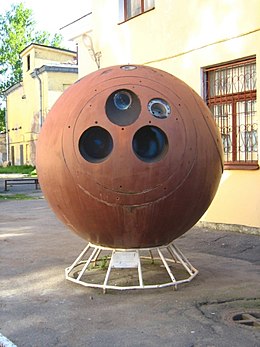Zenit (satellite)

Zenit re-entry capsule, showing camera ports
|
|
| Manufacturer | OKB-1 |
|---|---|
| Country of origin | Soviet Union |
| Applications | Photo reconnaissance |
| Production | |
| Status | Retired |
Zenit (Russian: Зени́т, IPA: [zʲɪˈnʲit], Zenith) was a series of military photoreconnaissance satellites launched by the Soviet Union between 1961 and 1994. To conceal their nature, all flights were given the public Kosmos designation. Over a 33 year period, over five hundred Zenits were flown making it the most numerous type of satellite in the history of spaceflight.
The basic design of the Zenit satellites was similar to the Vostok manned spacecraft, sharing the return and service modules. It consisted of a spherical re-entry capsule 2.3 m in diameter with a mass of around 2400 kg. This capsule contained the camera system, its film, recovery beacons, parachutes and a destruct charge. In orbit, this was attached to a service module that contained batteries, electronic equipment, an orientation system and a liquid fuelled rocket engine that would slow the Zenit for re-entry, before the service module detached. The total length in orbit was around 5 m and the total mass was between 4600 kg and 4740 kg.
Unlike the American Corona spacecraft, the return capsule carried both the film and the cameras and kept them in a temperature controlled pressurised environment. This simplified the design and engineering of the camera system but added considerably to the mass of the satellite. An advantage was that cameras could be reused.
Early Zenits were launched using the Vostok rocket; later versions used the Voskhod and the Soyuz rockets. The first flights were launched from Baikonur Cosmodrome but subsequent launches also took place at Plesetsk Cosmodrome.
Most Zenits flew in a slightly elliptical orbit with a perigee of around 200 km and an apogee between 250 km and 350 km; the missions usually lasted between 8 and 15 days.
...
Wikipedia
